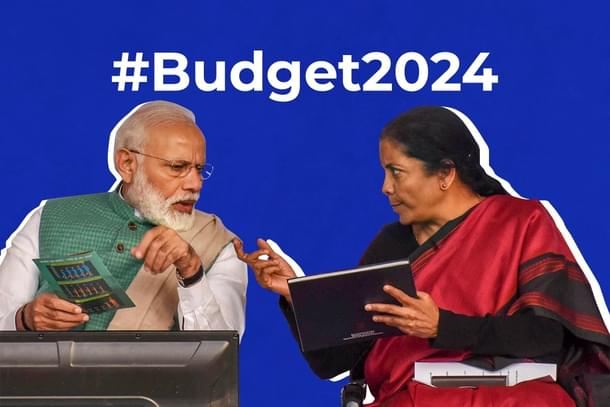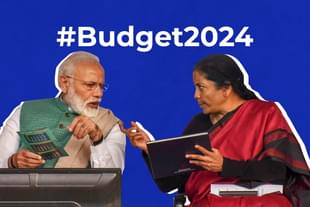News Brief
'Employment, Skilling, MSMEs And A Disappointed Middle Class': Nine Key Highlights Of Budget 2024-25
Swarajya Staff
Jul 23, 2024, 02:18 PM | Updated 02:32 PM IST
Save & read from anywhere!
Bookmark stories for easy access on any device or the Swarajya app.


Finance Minister Nirmala Sitharaman presented the Union Budget for the fiscal year 2024-25 in Parliament on Tuesday (24 July).
The budget outlines a roadmap for the pursuit of ‘Viksit Bharat’ and focuses on key areas such as agriculture, employment, manufacturing, urban development, and economic reforms.
The budget focuses on four major categories: Women, Poor, Youth, and Farmers, with emphasis on employment, skilling, MSMEs, and the middle class.
Here are the key highlights of the Budget 2024-25
1) Productivity and resilience in Agriculture
The budget places a strong emphasis on enhancing agricultural productivity and resilience.
Initiatives include promoting Farmer Producer Organisations (FPOs), cooperatives, and startups to improve vegetable supply chains. The government will introduce 109 new high-yielding and climate-resilient varieties of 32 crops to boost agricultural output.
Additionally, a comprehensive review of the agriculture research setup will focus on raising productivity and developing climate-resilient varieties.
The budget also supports natural farming, with plans to initiate 1 crore farmers into natural farming, supported by certification and branding over the next two years.
Financing for shrimp farming, processing, and export will be facilitated through NABARD.
The budget also proposes Digital Public Infrastructure (DPI) for coverage of farmers and their lands in three years, digital crop survey in 400 districts and issuance of Jan Samarth based Kisan Credit Cards.
2) Employment and Skilling
To facilitate higher participation of women in the workforce, the budget proposes the establishment of working women hostels and creches.
The budget also proposes Prime Minister's package for employment and skilling of 4.1 crore youth over a 5-year period with a central outlay of Rs 2 lakh crore.
One-month wage up to Rs 15,000 will be provided to new entrants in all formal sectors in three instalments, benefiting an estimated 2.1 crore youth.
Various schemes include incentives for EPFO contributions for first-time employees and reimbursement of EPFO contributions for employers, expected to generate significant job opportunities.
A skilling programme aims to skill 20 lakh youth over five years, with 1,000 Industrial Training Institutes being upgraded to meet industry needs.
Financial support for higher education loans up to Rs 10 lakh and direct e-vouchers for one lakh students every year are also included.
3) Inclusive Human Resource Development and Social Justice
The budget focuses on inclusive human resource development and social justice through the Purvodaya Initiative, aimed at generating economic opportunities in Eastern states such as Bihar, Jharkhand, West Bengal, Odisha, and Andhra Pradesh.
The budget proposes Amritsar Kolkata Industrial Corridor with development of an industrial node at Gaya.
Over Rs 3 lakh crore will be allocated for schemes benefiting women and girls.
The Pradhan Mantri Janjatiya Unnat Gram Abhiyan aims to improve the socio-economic conditions of tribal communities, covering 63,000 villages and benefiting 5 crore tribal people.
More than 100 branches of India Post Payment Bank will be set up in the North East region.
Financial support of Rs 15,000 crore will be provided for infrastructure projects in Andhra Pradesh, including the completion of the Polavaram Irrigation Project.
4) Manufacturing & Services
The budget proposes the development of twelve industrial parks under the National Industrial Corridor Development Programme to boost manufacturing and services.
Provision of internship opportunities in 500 top companies for 1 crore youth over five years is planned, with allowances and one-time assistance.
The Critical Minerals Mission proposed in the budget focuses on domestic production, recycling, and overseas acquisition of essential minerals for various industries.
Enhanced credit support and a new assessment model for MSME credit are to be introduced, along with an increase in Mudra loan limits to Rs 20 lakh under the ‘Tarun’ category.
Additional measures include support for industrial workers through rental housing with dormitory-type accommodation and strengthening of tribunals to speed up insolvency resolution.
5) Urban Development
An investment of Rs 10 lakh crore is planned to address the housing needs of 1 crore urban poor and middle-class families under PM Awas Yojana Urban 2.0.
States will be encouraged to lower stamp duties for properties purchased by women.
Promotion of water supply, sewage treatment and solid waste management projects and services for 100 large cities through bankable projects is also proposed in the budget.
The budget includes development plans for transit-oriented projects in 14 large cities and promotion of bankable water supply, sewage treatment, and solid waste management projects.
The budget also proposes launch of Phase IV of PMGSY aims to provide all-weather connectivity to 25,000 rural habitations, along with support for flood management projects in Assam, Sikkim, and Uttarakhand.
Initiatives also include the development of weekly ‘haats’ or street food hubs in select cities and policies for efficient and transparent rental housing markets.
6) Energy Security
The budget aims to enhance energy security through various initiatives, including financial support for shifting micro and small industries to cleaner energy forms and facilitating investment-grade energy audits in 60 clusters, expanding to 100 clusters in the next phase.
The establishment of Bharat Small Modular Reactors and newer technologies for nuclear energy, along with support for renewable energy integration and pumped storage projects, is also planned.
A joint venture between NTPC and BHEL will set up a full-scale 800 MW commercial plant.
A policy for promoting pumped storage projects will be brought out for electricity storage and facilitation of smooth integration of the growing share of renewable energy.
7) Infrastructure
A provision of Rs 11,11,111 crore is made for infrastructure development, which is 3.4 per cent of GDP.
The budget proposes Phase IV of PMGSY for all-weather rural connectivity, assistance for irrigation and flood mitigation projects in Assam, Sikkim and Uttarakhand, and assistance for reconstruction and rehabilitation in Himachal Pradesh.
Financial support for major infrastructure projects with estimated cost of Rs 11,500 crore such as the Kosi-Mechi intra-state link and other ongoing schemes will also be provided.
The budget also includes the development of Vishnupad Temple Corridor and Mahabodhi Temple Corridor, modelled on Kashi Vishwanath Temple Corridor, and comprehensive development initiatives for Rajgir, Nalanda, and Odisha as key tourism destinations.
8) Innovation, Research & Development
The budget proposes setting up of Anusandhan National Research Fund for basic research and prototype development.
A Rs 1,000 crore venture capital fund will be established to support space-related ventures.
The budget emphasises private sector-driven research and innovation at a commercial scale with a financing pool of Rs 1 lakh crore.
9) Next Generation Reforms
The next-generation reforms in the budget include the introduction of a Unique Land Parcel Identification Number (Bhu-Aadhaar) for all lands, digitisation of land records with GIS mapping, and the establishment of a land registry.
Taxonomy for climate finance will enhance the availability of capital for climate adaptation and mitigation investments.
Simplified FDI and overseas investment processes will promote the use of Indian Rupee for international transactions.
The New Pension Scheme (NPS) Vatsalya plan will allow contributions by parents and guardians for minors.
Additional reforms include simplification in taxes, litigation, and appeals processes, with a review of the Income Tax Act 1961 and changes in custom duty to support strategic sectors and domestic value addition.
During her speech, the Finance Minister said that the government has, in the budget, particularly focused on "employment, skilling, MSMEs, and the middle class".
However, the phrase "middle class" only appears once in the whole speech, with the phrases "employment", "skilling", and "MSMEs" appearing 34, 14 and 15 times, respectively.
Further, with the income tax related announcement, the Finance Minister disappointed the middle-class as the total savings for a salaried employee under the new tax regime across a whole year will stand at Rs 17,500, which is not a lot.
In a bid to increase the adoption of the new tax regime, the Finance Minister also announced that the standard deduction for salaried employees under the new regime will be increased from Rs 50,000 to Rs 75,000.





